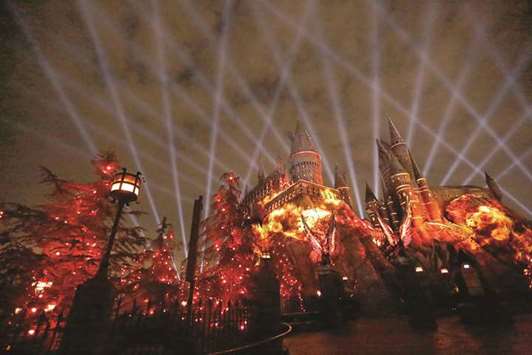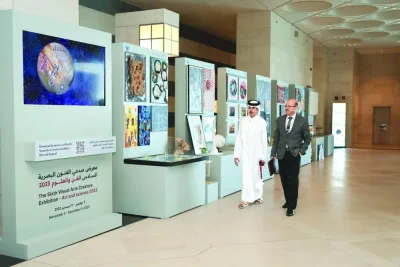At an after-party for the red carpet premiere of the seventh season of Game of Thrones at Walt Disney Concert Hall, partygoers watched as Westeros came to life on the building before them.
An icy visage of the Night King loomed over the affair while dragons soared across the hall’s sweeping arched facade, breathing flames that appeared to envelope the iconic structure.
Local designer Bart Kresa created the multimedia installation for the HBO event using a technique called projection mapping. Employing high-powered video projectors and sophisticated spatial mapping software, projection mapping enables artists and designers to cast virtual graphics onto the physical world, fitting them to the exact contours and dimensions of just about any surface.
Projected light shows have been popular in Europe for years, thanks to generous public funding for the arts. But as the underlying technology has advanced and become more affordable, projection mapping has exploded in the US.
LA in particular, with its year-round calendar of Hollywood premieres, parties and theme park events, has become a hotbed for this emerging medium. Projected installations have been recently featured at TCL Chinese Theatre and the Harry Potter attraction at Universal Studios Hollywood. Disneyland also showcases projections at a number of its attractions, including Sleeping Beauty Castle and It’s a Small World.
TV and film executives say the technology helps create social media buzz around certain events. “I had phone calls from vendors and friends around the world,” said Billy Butchkavitz, HBO’s event designer who used projection mapping for the premiere of Game of Thrones, Westworld and other shows.
“Whenever the budget allows I try to work in some form of projection mapping in the overall design of the event,” Butchkavitz said.
Many companies hired to work on these events are based in LA, tapping the city’s pool of experienced animators to meet a growing demand for projection mapping shows.
In addition to the HBO premiere, Kresa and his 30-person team at Bartkresa Studio have created shows for Disney, Warner Bros., Universal Studios and the Grammy Awards. A projection for a Warner Bros. party in 2012 filled nearly an entire movie studio lot, creating optical illusions that gave the multistory buildings the appearance of depth and movement.
“It’s a large-scale, bigger-than-life experience,” Kresa said.
To create a projection, mappers first take hundreds of photos of an object or building or use laser scanning technology to gather its exact dimensions. The information is then analysed by specialised software that stitches together a 3-D computer model of the structure. Onto the model, the software overlays graphics that are created using commercial animation programs. Next, designers produce a warped, two-dimensional image of the digital reproduction that perfectly fits to the shape of the physical object.
The final product is projected onto the space using extra-bright laser or LCD projectors built by retailers such as Panasonic and Epson, which can cost as much as $100,000 apiece. Kresa and his crew operated 12 projectors to cover the concert hall for the HBO after-party.
To captivate an audience, telling a compelling story with the technology is just as important as creating striking visual effects, said Garson Yu, founder and chief executive of LA-based design company YU+co.
Yu and his team of designers have projected New Year’s Eve light shows onto Los Angeles City Hall since 2015. The projections, which covered the historic building’s nearly 30-story face, not only featured dazzling 3-D effects but also each had unique narrative themes. One followed a young boy as he explored different neighbourhoods in LA and discovered the history of the city.
“When I look at a building, I don’t just look at it as an object or as a canvas we project an image onto,” Yu said. “I look at it as almost like a character — as something that carries a lot of stories and memories.”
Yu declined to reveal the company’s finances but said demand for projection mapping has helped boost his company’s revenue by more than 50 percent in recent years.
Philippe Bergeron, founder and head of LA-based projection mapping company Paintscaping, also has enjoyed brisk business since its founding in 2009.
Bergeron declined to reveal finances but said 2017 is poised to be the company’s most profitable year. The company usually charges $50,000 to $100,000 per project, Bergeron said.
Most of his team of 20 to 30 contractors have experience working in local film and video game studios such as Dreamworks Animation and Digital Domain. “There is an availability of the most incredible animators on the planet right here in LA,” Bergeron said.
LA County is a major hub for artistic talent with more than 5,800 animators and multimedia artists, according to the 2017 Otis Report on the Creative Economy.
Despite the abundance of quality animators, projection mapping makes up only a small fraction of event spending in LA. One reason is that it’s hard to get approvals. City officials can be reluctant to issue permits for large-scale installations, fearing they will distract drivers on local freeways.
Still, Kate Johnson, a digital media professor at Otis College, said an increase in public city-sponsored events is driving a higher demand for projection shows.
“Projection mapping has been huge throughout Europe, where it had a history of public gatherings,” Johnson said. “LA is now an emerging market because it’s beginning to figure out how to put on a big public event.”
Bergeron’s company has created a number of projections for public venues, including LA landmarks such as Rodeo Drive and the entertainment district called Hollywood and Highland Center, which has become a key source of revenue.
Paintscaping has produced mapping effects in music videos for Rihanna, John Legend and Eminem, as well as television commercials for Infiniti and BMW. For BMW, Bergeron and his team concocted projections that appeared to spiral and twist inside of the body of a car.
“It’s not just an artist’s paintbrush, but a new paradigm in lighting, marketing and entertainment,” Bergeron said.
Eventually, projection mapping may replace your smartphone. San Francisco startup Lightform is building a computer that will be able to attach to any projector and, in effect, turn it into a real-time 3-D scanner. It would enable an individual artist to project graphics onto an object at the same time he or she is designing them.
Lightform CEO Brett Jones said the computer will be available by fall. The company, which launched in 2014, has raised $2.6 million in seed funding and grants led by Silicon Valley venture capital firms Lux Capital and Seven Seas Partners.
“Projection mapping can provide visual illusions that are compelling magic, similar to (virtual reality) headsets that you would wear,” Jones said.
“In our version, you have projectors as light sources and every surface in a room can become an interactive display.”
In Jones’ future, which he refers to as “projected augmented reality (AR),” you’ll be able to order a ride with Lyft or shop on Amazon just by touching or talking to a projected display.
“We have a vision for being the Apple of projected AR,” Jones said.
Bergeron also predicts a bright future for projection mapping.
“I see every light bulb being an intelligent light bulb that can scan in 3-D in real time and re-project,” he said. “In the future, we’re not going to be able to trust reality because we will be able to create effects that are so incredibly real that you’re not going to know the difference.” —Los Angeles Times/TNS

SPECTACULAR: The Nighttime Lights at Hogwarts Castle Gryffindor House imagery is projected against Hogwarts Castle against a web of spot lights as part of the new light show for The Wizarding World of Harry Potter, at Universal Studios. The addition to the site is a colourful state-of-the-art light display and special effects projection accompanied by an original arrangement overseen by Academy-Award winning composer John Williams.


